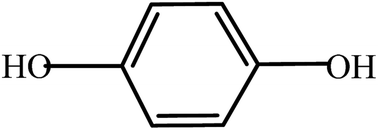A novel simple sensitive and inexpensive method based on the formation of Turnbull's blue nanoparticles using resonance Rayleigh scattering has been developed for the determination of hydroquinone (HQ). The results show that Fe3+ is deoxidized to Fe2+ by hydroquinone in pH 2.7 HCl (0.002 mol L−1) solution, then Fe2+ reacts with potassium ferricyanide to form a soluble Turnbull's blue (KFe[Fe(CN)6]), and further aggregates to form {KFe[Fe(CN)6]}n nanoparticles. These results induce a significant enhancement of resonance Rayleigh scattering (RRS). The maximum scattering wavelength of the ion-association complex is located at about 310 nm. The increment of scattering intensity (IRRS) is directly proportional to the concentration of HQ in the range of 0.46–50.0 μmol L−1. This method has high sensitivity and the detection limit (3σ/k) for HQ is 0.14 μmol L−1. In this work, the characteristics of absorption and RRS spectra of this reaction have been studied. The optimum reaction conditions and influencing factors have been investigated. Furthermore, the reaction mechanism and the reasons for the RRS enhancement have been explored. Additionally, the method is applied to the determination of HQ in local river water samples with satisfactory results.

